ZTE ZTEGRANDS WCDMA/GSM (GPRS) Dual-Mode Digital Mobile Phone User Manual ZTE Grand S
ZTE Corporation WCDMA/GSM (GPRS) Dual-Mode Digital Mobile Phone ZTE Grand S
ZTE >
UserMan
1
ZTE Grand S
Quick Start Guide

2
LEGAL INFORMATION
Copyright © 2013 ZTE CORPORATION.
All rights reserved.
No part of this publication may be quoted, reproduced,
translated or used in any form or by any means, electronic or
mechanical, including photocopying and microfilm, without the
prior written permission of ZTE Corporation.
Notice
ZTE Corporation reserves the right to make modifications for
print errors or update specifications in this guide without prior
notice.
We offer self-service for our smart terminal device users. Please
visit the ZTE official website (at www.ztedevice.com)) for more
information on self-service and supported product models.
Information on the website takes precedence.
Disclaimer
ZTE Corporation expressly disclaims any liability for faults and
damages caused by unauthorized modifications of the software.
Images and screenshots used in this guide may differ from the
actual product. Content in this guide may differ from the actual
product or software.

3
Trademarks
ZTE and the ZTE logos are trademarks of the ZTE
Corporation.
Google and Android are trademarks of Google, Inc.
Manufactured under license from Dolby Laboratories. Dolby
and the double-D symbol are trademarks of Dolby
Laboratories.
The Bluetooth® trademark and logos are owned by the
Bluetooth SIG, Inc. and any use of such trademarks by ZTE
Corporation is under license.
The microSD logo is a trademark of the SD-3C LLC.
Other trademarks and trade names are the property of their
respective owners.
Version No. : R1.0
Edition Time : 20130819
Manual No. :
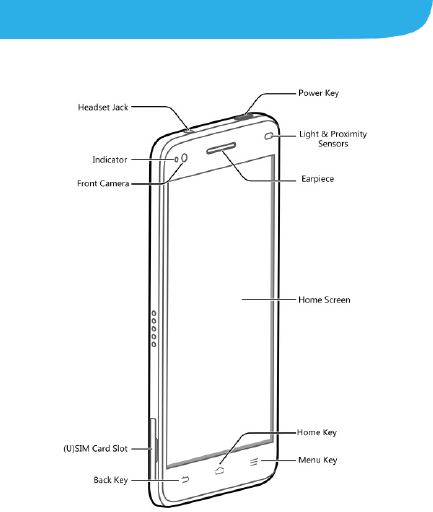
4
Getting to Know Your Phone
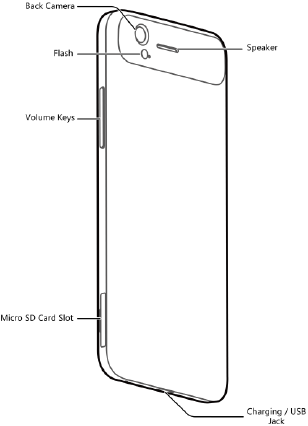
5

6
Power Key
Press and hold to power on, select phone modes, turn on/off
airplane mode, reset, power off.
Press to turn off or on the screen display.
Home Key
Touch to return to the home screen from any application or
screen.
Touch and hold to see recently used applications.
Menu Key
Touch to get the options for the current screen.
Back Key
Touch to go to the previous screen.
Volume Keys
Press or hold to turn the volume up or down.
Starting Up
Switch off your phone before installing or replacing the SIM card.
The microSD card is optional and can be installed and removed
while the phone is turned on. Unmount the microSD card before
removing it.
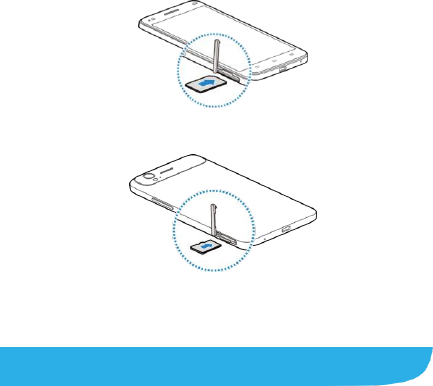
7
1. Insert the SIM card.
2. Insert the microSD card.
NOTE: Your phone may come with a pre-installed microSD
card. Some applications may not function normally after you
remove the card, pre-installed or otherwise.
Charging the Battery
1. Connect the adapter to the charging jack. Ensure that the
adapter is inserted with the correct orientation. Do not force the
connector into the charging jack.
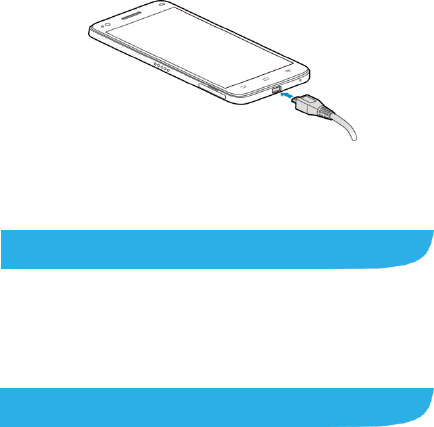
8
2. Connect the charger to a standard AC power outlet.
3. Disconnect the charger when the battery is fully charged.
Powering On/Off Your Phone
Make sure the battery is charged before powering on.
Press and hold the Power Key to turn on your phone.
To turn it off, press and hold the Power Key to open the
options menu. Touch Power off > OK.
Getting to Know the Home Screen
The home screen is the starting point for your phone’s
applications, functions, and menus. You can customize your
home screen by adding application shortcuts, folders, widgets,
and more.
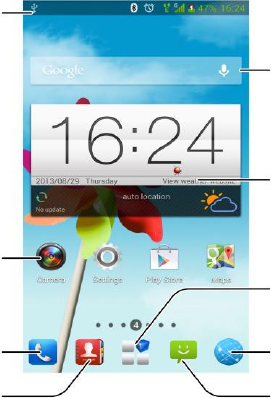
9
Browser
Status Bar
Shortcuts
Phone
People
All Apps
Messaging
Widget
Google Search

10
NOTE: Your home screen extends beyond the initial screen,
providing more space for shortcuts, widgets, and folders. Simply
swipe left or right to see the extended home screens.
Opening Applications
1. Touch the Home Key if the current screen is not the home
screen.
2. Touch .
3. Slide left or right on the screen and touch an app to open it.
Adding Shortcuts or Widgets
1. Touch the Home Key > .
2. If you want to add a widget, touch WIDGETS.
3. Touch and hold a widget or an app icon and drag it to the
home screen.

11
Removing Shortcuts or Widgets
1. Touch and hold a widget or shortcut on the home screen.
2. Drag it to to remove it.
Organizing Shortcuts with Folders
1. Touch and hold a shortcut on the home screen.
2. Drag it to . A new folder is created and the shortcut
is added into the folder.
3. If needed, drag more shortcuts and drop them into the folder.
Applying New Wallpapers
You can set the wallpaper for the home screen or lock screen.
1. Touch the Home Key > Menu Key > Customization settings.
2. Touch Wallpaper for Home screen or Wallpaper for Lock
screen.
3. Select a wallpaper source from Gallery, Live Wallpapers,
or Wallpapers and touch the image or animation you want
to use as the wallpaper.
4. Touch Done at the top of the screen (for Gallery images) or Set
wallpaper.
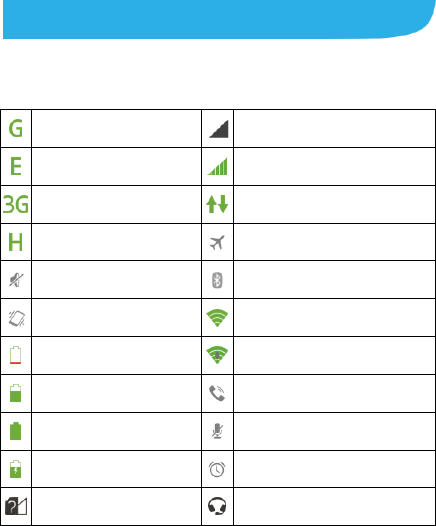
12
Checking the Phone Status
The status bar at the top of the screen displays phone and service
status with various icons on the right side. Below are some of the
icons and their meanings.
GPRS connected
No signal
EDGE connected
Signal strength
3G connected
Mobile data in use
HSPA connected
Flight mode
Ringer off
Bluetooth on
Vibrate mode
Connected to a Wi-Fi network
Battery low
Wi-Fi in use
Battery partially drained
Speaker on
Battery full
Phone microphone off
Battery charging
Alarm set
No SIM card installed
Wired headset connected
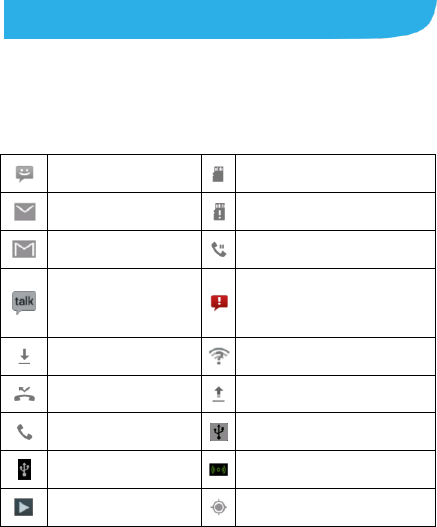
13
Managing Notifications
The status bar at the top of the screen provides notification alerts
with different icons on the left side. Below are some of the icons
and their meanings.
The notifications depend on the apps installed and you can touch
and drag the status bar down to see more information.
New SMS / MMS
microSD card unmounted
New Email
microSD card removed
New Gmail message
Call on hold
New Google Talk
instant message
Problem with SMS/MMS
delivery
Downloading data
New Wi-Fi network detected
Missed call
Sending data
Call in progress
USB tethering is on
USB connected
Portable Wi-Fi hotspot
Song is playing
GPS on

14
Setting Ringtone and Sounds
Setting Ringtone or Notification Sound
1. Touch the Home Key > Menu Key > System settings >
Sound.
2. Touch Phone ringtone or Default notification.
3. Select the ringtone you want to use.
4. Touch OK.
Setting System Sounds
1. Touch the Home Key > Menu Key > System settings >
Sound.
2. Scroll to the SYSTEM section and check the sounds you want
to hear or uncheck those you do not need.

15
Adjusting Volumes
To adjust call volume, press the Volume Key while on a call. To
adjust other volumes, follow the steps below.
1. Touch the Home Key > Menu Key > System settings >
Sound > Volumes.
2. Drag the sliders to adjust the volume for music, video, games,
and other media, the ringtone and notification volume, and the
alarm volume.
3. Touch OK to save.
TIP: Press and hold the Power Key and then touch to enable
the silent mode, touch to enable the vibration mode, or touch
to disable the silent mode.

16
Setting a Screen Lock
You can protect your phone by creating a screen lock. When
enabled, you need to unlock the phone’s screen and keys.
1. Touch the Home Key > Menu Key > System settings >
Security > Screen lock.
2. Touch None, Long press, Pattern, PIN or Password.
Touch None to unlock the screen.
Touch Long press to enable unlock with a ‘touch and hold’
gesture. You can unlock the screen by touching and holding
at the center of the display.
Touch Pattern to create a pattern that you must draw to
unlock the screen.
Touch PIN or Password to set a numeric PIN or a
password you must enter to unlock your screen.
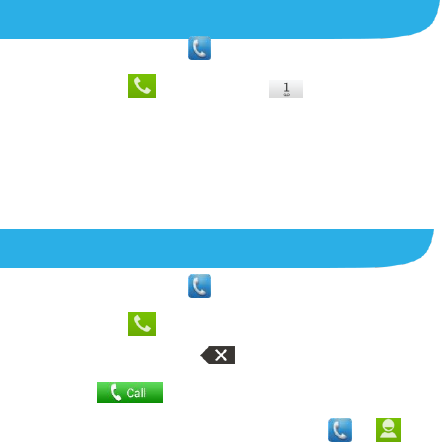
17
Checking Voicemail
1. Touch the Home Key > .
2. In the dialer tab , touch and hold . If prompted, enter
your voicemail password.
3. Follow the voice prompts to listen to and manage your
voicemail messages.
Making a Call
1. Touch the Home Key > .
2. In the dialer tab , enter the phone number with the
on-screen keypad. Touch to delete incorrect digits.
3. Touch the icon below the keypad to place the call.
NOTE: To call a contact, touch the Home Key > > and
touch a contact and number.

18
Adding Contacts
Creating a New Contact
1. Touch the Home Key > > and touch the all contacts
tab .
2. Touch to create a new contact.
3. Enter the contact name, phone numbers, email addresses, and
other information, as shown. Touch Save to save the contact.
Importing Contacts in Batches
1. Touch the Home Key > > .
2. Touch the Menu Key > Import/export > Import from SIM
card or Import from SD card or Import from phone
storage.
3. If prompted, select an account in which to save the contacts.
4. For importing from the SIM card, touch all the SIM contacts
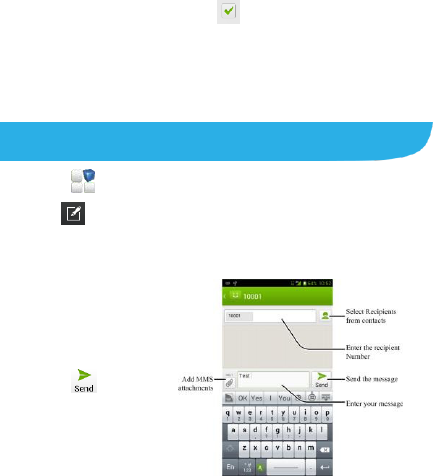
19
you want to import and touch .
For importing from the microSD card or phone card, select the
vCard file(s) on the microSD card and touch OK to begin
importing.
Sending a Message
1. Touch in the home screen and select Messaging, then
touch .
2. Enter the recipient(s) and message text. If you want to send
an MMS, add
subject and
attachments.
3. Touch to send
the message.

20
Setting Up Email Accounts
Setting Up Gmail
1. Touch in the home screen and select Gmail.
NOTE: If another Gmail account is already set up, touch the
Menu Key > System settings > ADD ACCOUNT.
2. Touch Existing to sign in to your existing Google Account. If
you have no Google Accounts, touch New to create one.
3. Follow the instructions on the screen to set up the account.
Setting Up Email
1. Touch in the home screen and select Email.
NOTE: If another email account is already set up, touch the
Menu Key > Account settings > Add account.
2. Enter the email address and password.
3. Touch Next and follow the onscreen instructions.

21
Setting Up Corporate Exchange Email
1. Touch in the home screen and select Email.
NOTE: If another email account is already set up, touch the
Menu Key > Account settings > Add account.
2. Enter the email address and password.
3. Touch Manual setup > Exchange.
4. Enter Domain\Username, Password, and Server
information.
5. Read the onscreen activation disclaimer and, if prompted,
touch Next.
6. If prompted, touch OK to allow the server to remotely control
some of your phone’s security features.
7. Configure the settings on the screen, such as Days to sync,
and then touch Next.
8. If prompted, touch Activate to activate the Email app as a
device administrator.
9. Identify your new account with a unique name and then touch
Next.

22
Contact your server administrator for more help.
Connecting with a Bluetooth
Headset
1. Turn on the Bluetooth headset and switch it to pairing mode.
Refer to the headset’s user guide for more information.
2. Touch in the home screen and select Settings >
Bluetooth.
3. Slide the ON/OFF switch if Bluetooth is off. When Bluetooth is
on, the icon appears in the status bar.
NOTE: Your phone automatically scans for and displays the
IDs of all available Bluetooth devices in range. Touch Search
for devices if you want to scan for Bluetooth devices again.
4. Touch the ID of the headset, or any other device you want to
pair with your phone. Enter a passcode if prompted.
5. If necessary, touch the ID of the paired headset to connect
with it. Once connected, the icon in the status bar turns

23
blue.
TIP: Touch the ID again to end the connection.
Installing Apps from the Google
Play Store
There are tens of thousands of games and applications in the
Google Play Store for you to download and install. You can send
feedback or comments on an application.
Before you begin, make sure that you have signed in to your
Google account.
NOTE: The content you can access in the Play Store depends on
your region and your service provider.
1. Touch the Home Key > > Play Store.
The first time you launch Play Store, accept the Google Play
Terms of Service.
2. Find the apps you want either by category or by touching .

24
3. Touch the app to see detailed description.
4. Touch Download (free apps) or the price (paid apps). If the
app is not free, you need to sign in to your Google Wallet
account and select a payment method.
CAUTION: Once installed, some apps can access many
functions or a significant amount of your personal data. The
Play Store will show you what the app can access. Touch
Accept to proceed, or touch the Back Key to cancel.
5. Wait for the app to be downloaded and installed automatically.
Payment needs to be authorized before paid apps start
downloading.
The app is successfully installed when the icon appears in
the status bar. You can find the new app after touching the Home
Key > .
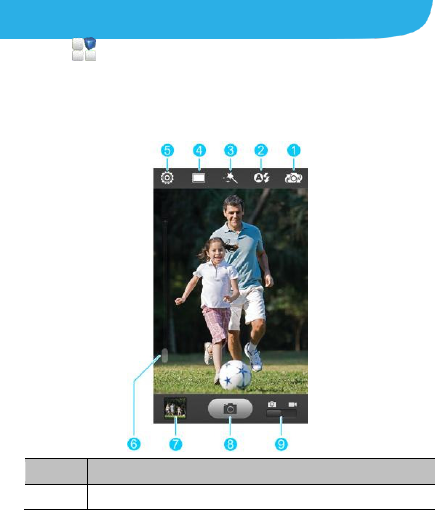
25
Taking a Photo
1. Touch in the home screen and select Camera.
2. Aim the camera at the subject and make any necessary
adjustment.
Number
Function
1
Switch between the front and back camera.
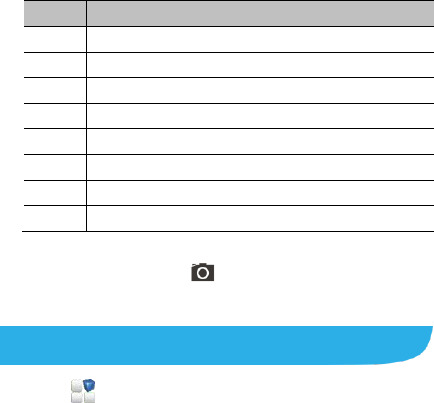
26
Number
Function
2
Choose flash mode (for the back camera).
3
Select color effect (for the back camera).
4
Choose photo camera mode.
5
Adjust camera settings.
6
Slide to zoom in or out.
7
View photos and videos you have captured.
8
Capture a photo.
9
Switch to the camcorder.
3. Lightly touch the button , or press the Volume Up or
Volume Down Key to capture a photo.
Recording a Video
1. Touch in the home screen and select Camcorder, or
switch to the camcorder from the camera screen.
2. Aim the camera at the subject and make any necessary
adjustment.
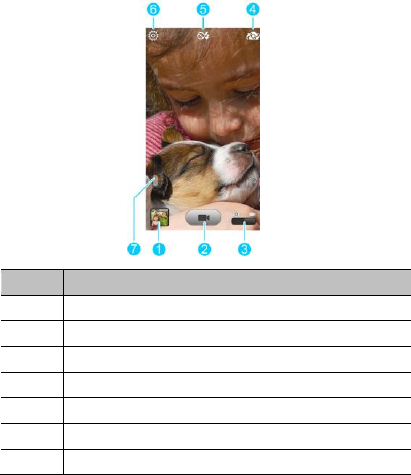
27
Number
Function
1
View photos and videos you have captured.
2
Start or stop recording a video.
3
Switch to the camera.
4
Switch between the front and back camera.
5
Change flash mode (for the back camera).
6
Adjust the camcorder settings.
7
Slide to zoom in or out.

28
3. Touch the button to start recording.
4. Touch to stop recording.
TIP: While the recording is in progress, you can touch to
save the frame as a photo.
Playing Music
1. Touch in the home screen and select Music.
2. Touch a category, such as Artists or Albums, to find the song
you want to play.
3. Touch the song to play it back. When the song is playing,
touch the album artwork to display more options.
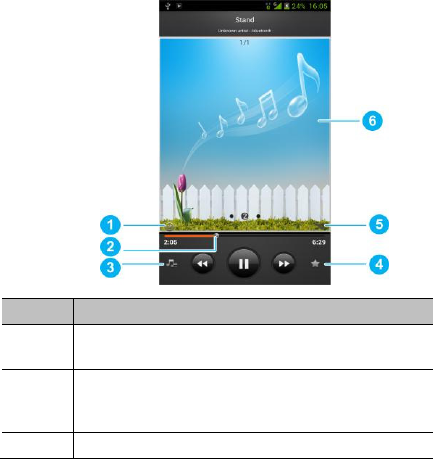
29
Number
Function
1
Touch to toggle repeat mode: no repeat, repeat the
current song, or repeat the current playlist.
2
Playback control. Skip songs or pause and resume
playback. Drag the slider to jump to any part of the
song.
3
Touch to return to the music library.

30
4
Touch to add the song to or remove it from favorites.
Your favorite songs can be found in the Favorite
playlist in the Playlists tab.
5
Touch to play the current playlist in shuffle mode,
where tracks are played in random order.
6
Album artwork. Swipe left or right to see lyrics (if
available) or the current playlist.
Connecting to PC
You can connect your phone to a computer with a USB cable and
transfer music, pictures, and other files in either direction. Your
device stores these files in internal storage or on a removable
microSD card.
1. Touch and hold the status bar across the top of the screen
and flick down.
2. Touch (Connected as [current connection mode]).
3. Choose one of the following options:
Charger only: Charge your phone via USB.
USB Mass Storage: Use the tablet as a USB modem.
Install driver: Install the driver of the tablet on a PC.
Connect to PC software: Sync the tablet with a PC.
Media device (MTP): Transfer media files in Windows,

31
or use Android File Transfer on Mac.
Camera (PTP): Transfer photos using camera software,
and transfer any files on computers that don’t support
MTP.
To disconnect the device from the computer, simply unplug the
USB cable when you’re finished.
Connecting to the Internet
Connecting via Wi-Fi
1. Touch the Home Key > Menu Key > System settings >
Wi-Fi.
2. Slide the ON/OFF switch if Wi-Fi is off.
Your phone automatically searches for Wi-Fi networks in
range and displays their names and security settings. Your
phone also connects to previously linked networks when they
are in range.
3. Touch a network name to connect to it.
If the network is secured, enter a password or other
credentials. (Ask your network administrator for details.)
Connecting via Mobile Network
To connect to the Internet via mobile network, you can use the

32
default Access Point Names (APN). And if you want to add a new
APN, please contact the service provider to get the necessary
information. Do not change the settings as the service might stop
working.
1. Touch the Home Key > Menu Key > System settings >
More > Mobile networks > Access Point Names.
2. Touch the Menu Key > New APN.
3. Touch each item to enter the information you get from your
service provider.
4. Touch the Menu Key > Save to complete.
Freeing Up Memory Space
Use Task Manager to free up memory space and optimize
system speed.
1. From the home screen, touch > Task Manager.
2. Touch the Tasks tab and touch the Close button next to the
application you do not need.
You can also touch Close All to stop all running applications.
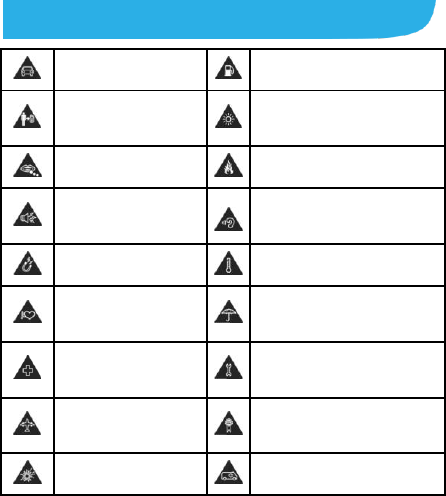
33
Product Safety Information
Do not use hand-held
devices while driving
Do not use while re-fuelling
For body-worn operation
maintain a separation of
15 mm
This device may produce a
bright or flashing light
Small parts may cause a
choking hazard
Do not dispose of it in a fire
This device may produce
a loud sound
To prevent possible hearing
damage, do not listen at high
volume levels for long periods.
Avoid contact with
magnetic media
Avoid Extreme Temperatures
Keep away from
pacemakers and other
personal medical devices
Avoid any contact with liquid,
keep it dry
Switch off when
instructed in hospitals
and medical facilities
Do not attempt to disassemble
Switch off when
instructed in aircrafts and
airports
Only use approved accessories
Switch off in explosive
environments
Do not rely on this device for
emergency communications

34
Declaration of RoHS Compliance
To minimize the environmental impacts and take more responsibility for the
earth we live on, this document shall serve as a formal declaration that the ZTE
Grand S manufactured by ZTE CORPORATION is in compliance with the
Directive 2002/95/EC of the European Parliament - RoHS (Restriction of
Hazardous Substances), with respect to the following substances:
1. Lead (Pb)
2. Mercury (Hg)
3. Cadmium (Cd)
4. Hexavalent Chromium (Cr (VI))
5. Polybrominated biphenyls (PBBs)
6. Polybrominated diphenyl ethers (PBDEs)
The ZTE Grand S manufactured by ZTE CORPORATION meets the
requirements of EU 2002/95/EC.

35
Disposal of Your Old Appliance
1. When this crossed-out wheeled bin symbol is attached to
a product, it means the product is covered by the
European Directive 2002/96/EC.
2. All electrical and electronic products should be disposed
of separately from the municipal waste stream via
designated collection facilities appointed by the
government or the local authorities.
3. The correct disposal of your old appliance will help
prevent potential negative consequences to the
environment and human health.
For this product’s recycling information based on WEEE directive, please
send an e-mail to weee@zte.com.cn

36
FCC Regulations
This mobile phone complies with part 15 of the FCC Rules. Operation is
subject to the following two conditions: (1) This device may not cause
harmful interference, and (2) this device must accept any interference
received, including interference that may cause undesired operation.
This mobile phone has been tested and found to comply with the limits for a
Class B digital device, pursuant to Part 15 of the FCC Rules. These limits
are designed to provide reasonable protection against harmful interference
in a residential installation. This equipment generates, uses and can
radiated radio frequency energy and, if not installed and used in
accordance with the instructions, may cause harmful interference to radio
communications. However, there is no guarantee that interference will not
occur in a particular installation If this equipment does cause harmful
interference to radio or television reception, which can be determined by
turning the equipment off and on, the user is encouraged to try to correct
the interference by one or more of the following measures:
-Reorient or relocate the receiving antenna.
-Increase the separation between the equipment and receiver.
-Connect the equipment into an outlet on a circuit different from that to
which the receiver is connected.
-Consult the dealer or an experienced radio/TV technician for help.
FCC NOTE:
Caution: Changes or modifications not expressly approved by the party
responsible for compliance could void the user‘s authority to operate the
equipment.

37
RF Exposure Information (SAR)
This phone is designed and manufactured not to exceed the emission limits
for exposure to radio frequency (RF) energy set by the Federal
Communications Commission of the United States, Industry Canada of
Canada.
During SAR testing, this device was set to transmit at its highest certified
power level in all tested frequency bands, and placed in positions that
simulate RF exposure in usage against the head with no separation, and
near the body with the separation of 10 mm. Although the SAR is
determined at the highest certified power level, the actual SAR level of the
device while operating can be well below the maximum value. This is
because the phone is designed to operate at multiple power levels so as to
use only the power required to reach the network. In general, the closer
you are to a wireless base station antenna, the lower the power output.
The exposure standard for wireless devices employing a unit of
measurement is known as the Specific Absorption Rate, or SAR. The SAR
limit set by the FCC is 1.6W/kg, and 1.6W/kg by Industry Canada.
This device is complied with SAR for general population /uncontrolled
exposure limits in ANSI/IEEE C95.1-1992 and Canada RSS 102 and had
been tested in accordance with the measurement methods and procedures
specified in IEEE1528, and Canada RSS 102. This device has been tested,
and meets the FCC, IC RF exposure guidelines when tested with the device
directly contacted to the body.
The FCC has granted an Equipment Authorization for this model phone
with all reported SAR levels evaluated as in compliance with the FCC RF
exposure guidelines. SAR information on this model phone is on file with
the FCC and can be found under the Display Grant section of
www.fcc.gov/oet/ea/fccid after searching on FCC ID: SRQ-ZTEGRANDS.
38
For this device, the highest reported SAR value for usage against the head
is 0.76W/kg, for usage near the body is 1.44 W/kg.
While there may be differences between the SAR levels of various phones
and at various positions, they all meet the government requirements.
SAR compliance for body-worn operation is based on a separation distance
of 10 mm between the unit and the human body. Carry this device at least
10 mm away from your body to ensure RF exposure level compliant or
lower to the reported level. To support body-worn operation, choose the belt
clips or holsters, which do not contain metallic components, to maintain a
separation of 10 mm between this device and your body.

39
IC Notice
This mobile phone complies with Industry Canada license-exempt RSS
standard(s). Operation is subject to the following two conditions:
(1) this device may not cause interference, and
(2) this device must accept any interference, including interference that may
cause undesired operation of the device.
Le présent appareil est conforme aux CNR d'Industrie Canada applicables
aux appareils radio exempts de licence. L'exploitation est autorisée aux
deux conditions suivantes:
(1) l'appareil ne doit pas produire de brouillage, et
(2) l'utilisateur de l'appareil doit accepter tout brouillage radioélectrique subi,
même si le brouillage est susceptible d'en
This Class B digital apparatus complies with Canadian ICES-003.
Cet appareil numérique de la classe B est conforme à la norme NMB-003
du Canada.
IC: 5200E-ZTEGRANDS

40
IC Radiation Exposure Statement
This EUT is compliance with SAR for general population/uncontrolled
exposure limits in IC RSS-102 and had been tested in accordance with the
measurement methods and procedures specified in IEEE 1528 and IEC
62209. This equipment should be installed and operated with minimum
distance 1.0 cm between the radiator and your body. This device and its
antenna(s) must not be co-located or operating in conjunction with any other
antenna or transmitter.
Cet appareil est conforme aux limites d'exposition DAS incontrôlée pour la
population générale de la norme CNR-102 d'Industrie Canada et a été testé
en conformité avec les méthodes de mesure et procédures spécifiées dans
IEEE 1528 et IEC 62209. Cet appareil doit être installé et utilisé avec une
distance minimale de 1.0 cm entre l’émetteur et votre corps. Cet appareil et
sa ou ses antennes ne doivent pas être co-localisés ou fonctionner en
conjonction avec tout autre antenne ou transmetteur.

41
Hearing Aid Compatibility (HAC)
regulations for Mobile phones
In 2003, the FCC adopted rules to make digital wireless telephones
compatible with hearing aids and cochlear implants. Although analog
wireless phones do not usually cause interference with hearing aids or
cochlear implants, digital wireless phones sometimes do because of
electromagnetic energy emitted by the phone's antenna, backlight, or other
components. Your phone is compliant with FCC HAC regulations (ANSI
C63.19- 2007). While some wireless phones are used near some hearing
devices (hearing aids and cochlear implants), users may detect a buzzing,
humming, or whining noise. Some hearing devices are more immune than
others to this interference noise and phones also vary in the amount of
interference they generate. The wireless telephone industry has developed
a rating system for wireless phones to assist hearing device users in finding
phones that may be compatible with their hearing devices. Not all phones
have been rated. Phones that are rated have the rating on their box or a
label located on the box. The ratings are not guarantees. Results will vary
depending on the user's hearing device and hearing loss. If your hearing
device happens to be vulnerable to interference, you may not be able to
use a rated phone successfully. Trying out the phone with your hearing
device is the best way to evaluate it for your personal needs.
This phone has been tested and rated for use with hearing aids for some of
the wireless technologies that it uses. However, there may be some newer
wireless technologies used in this phone that have not been tested yet for
use with hearing aids. It is important to try the different features of this
phone thoroughly and in different locations, using your hearing aid or
cochlear implant, to determine if you hear any interfering noise. Consult
your service provider or the manufacturer of this phone for information on
hearing aid compatibility. If you have questions about return or exchange
policies, consult your service provider or phone retailer.
M-Ratings: Phones rated M3 or M4 meet FCC requirements and are likely
42
to generate less interference to hearing devices than phones that are not
labeled. M4 is the better/higher of the two ratings.
T-Ratings: Phones rated T3 or T4 meet FCC requirements and are likely to
be more usable with a hearing device’s telecoil (“T Switch” or “Telephone
Switch”) than unrated phones. T4 is the better/ higher of the two ratings.
(Note that not all hearing devices have telecoils in them.)
Your phone meets the M3/T4 level rating.
Hearing devices may also be rated. Your hearing device manufacturer or
hearing health professional may help you find this rating. For more
information about FCC Hearing Aid Compatibility, please go to
http://www.fcc.gov/cgb/dro.